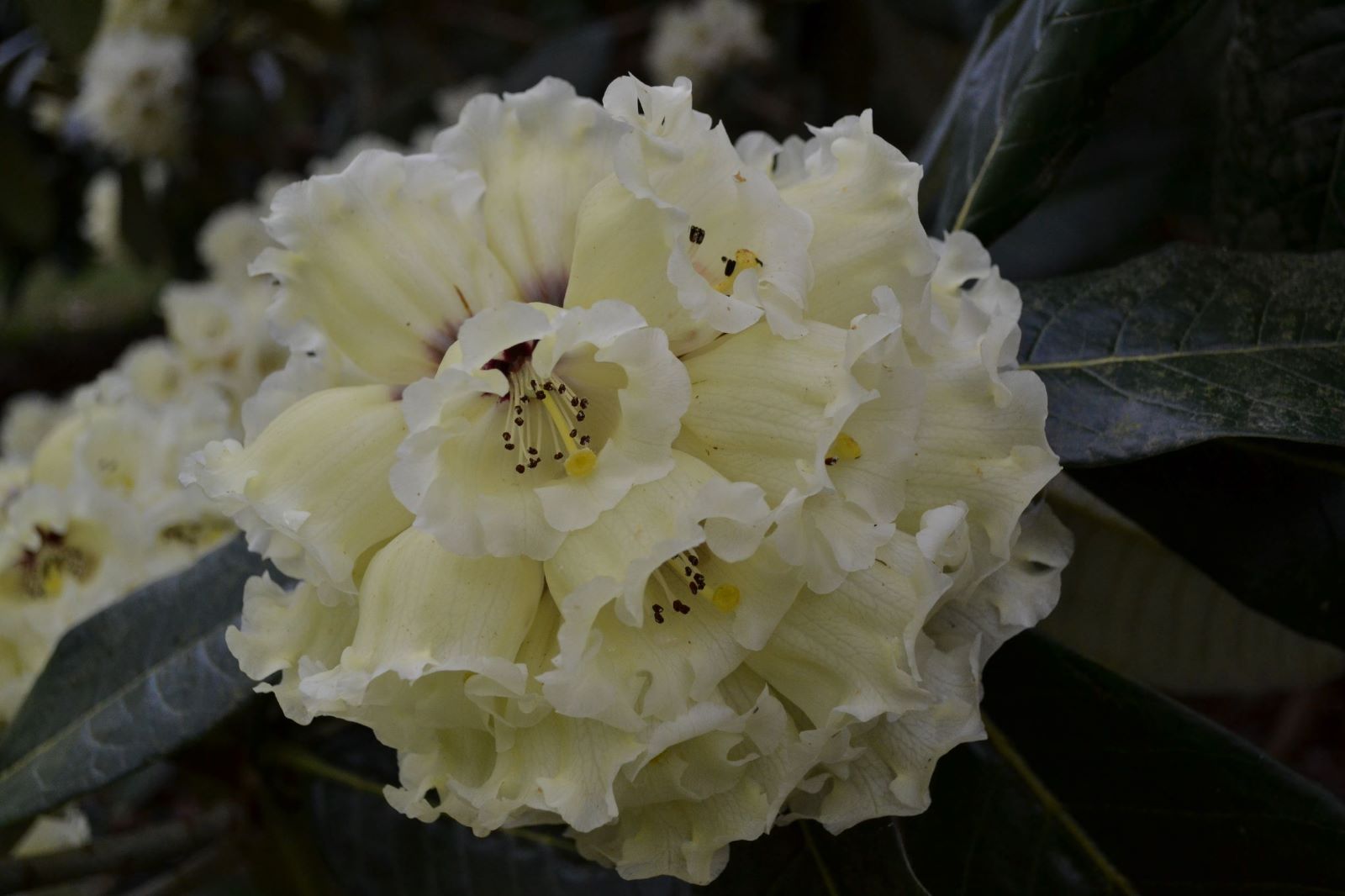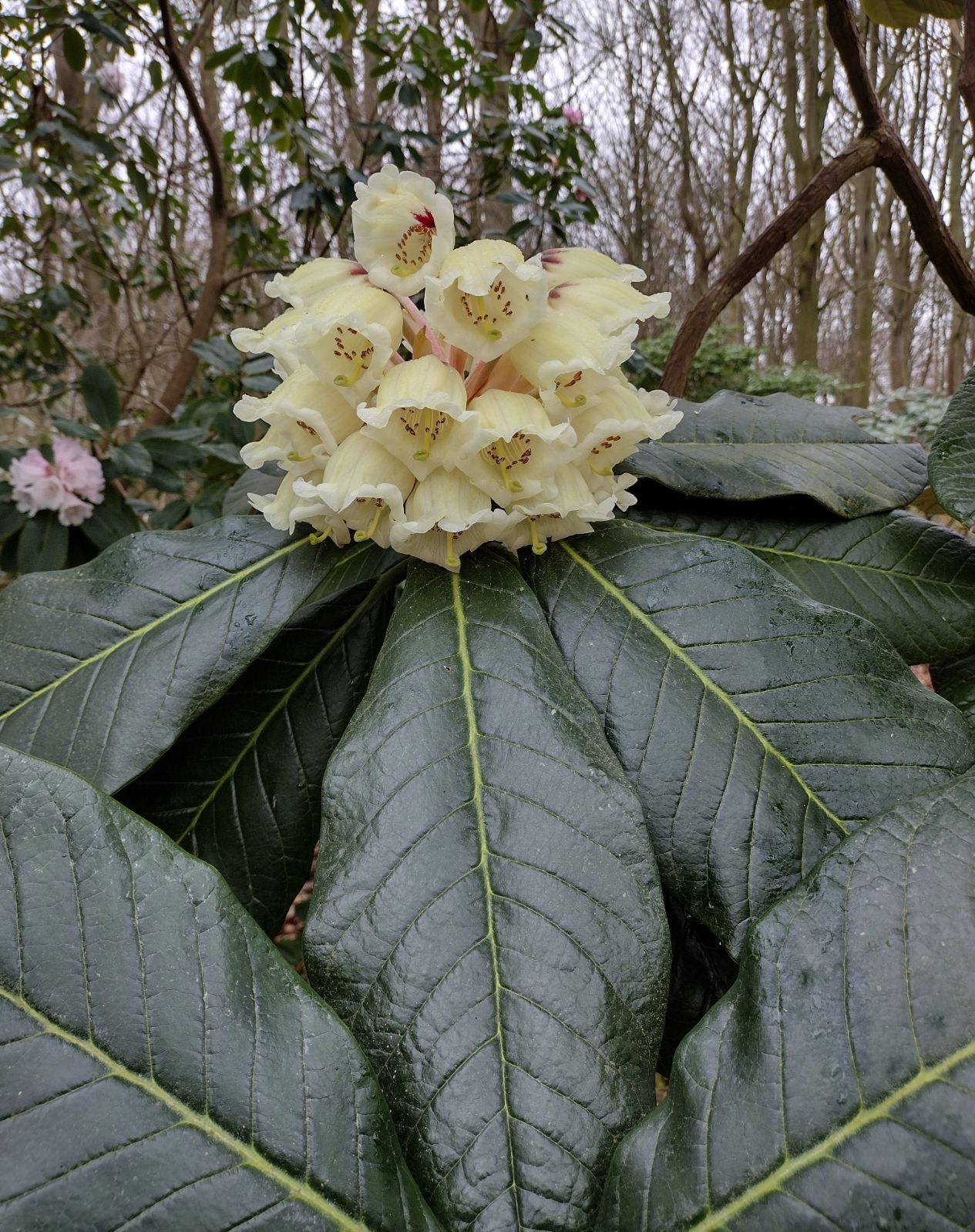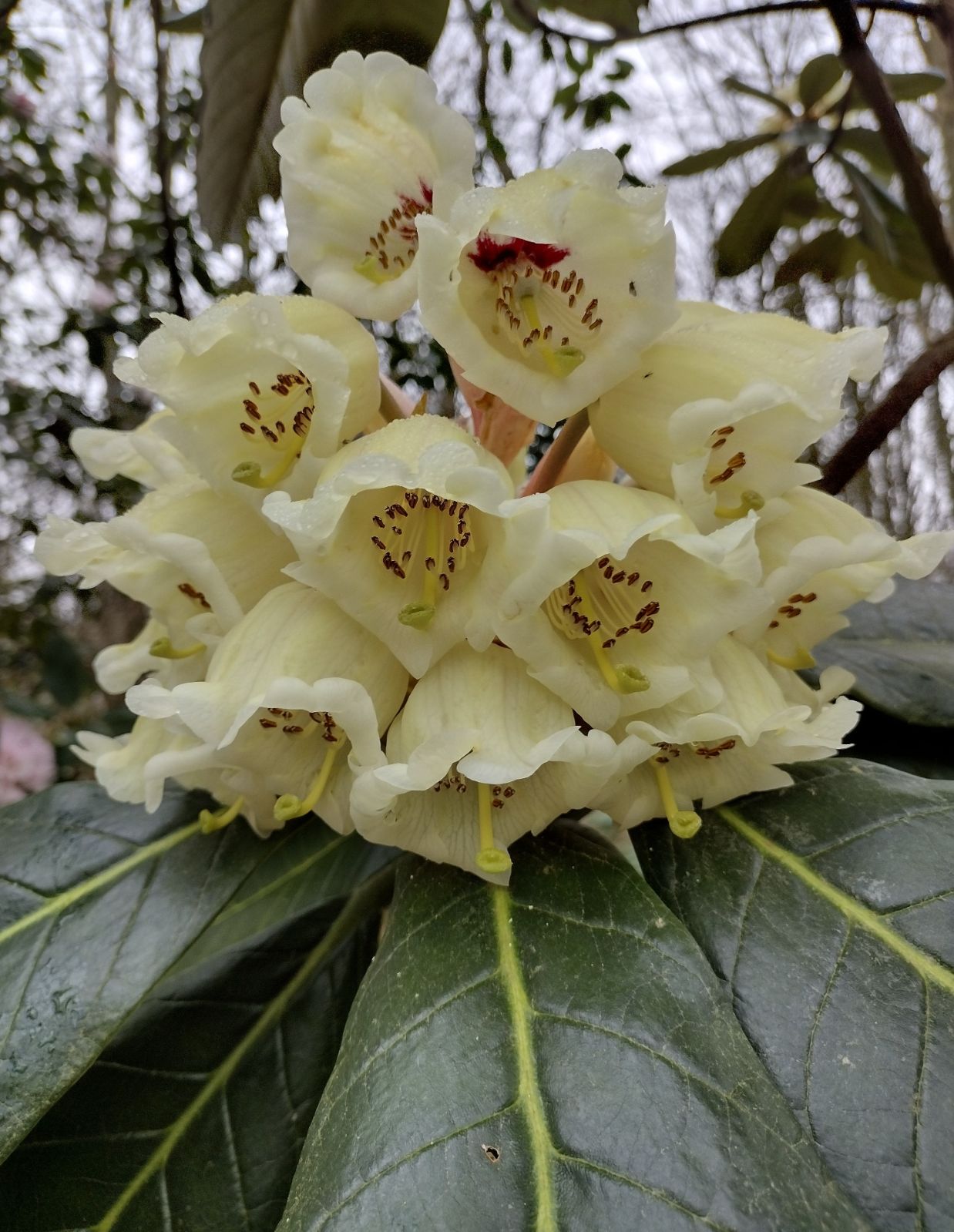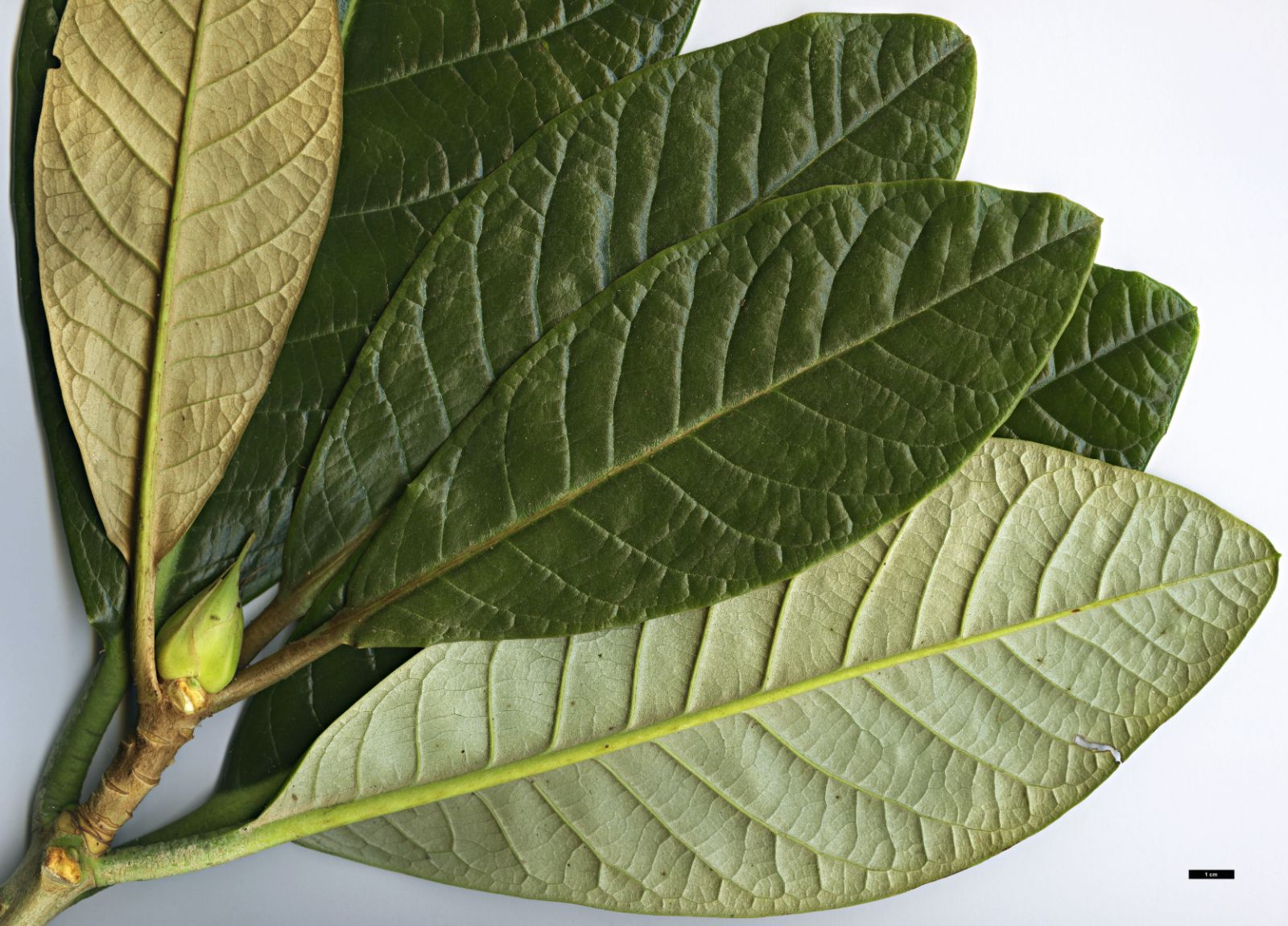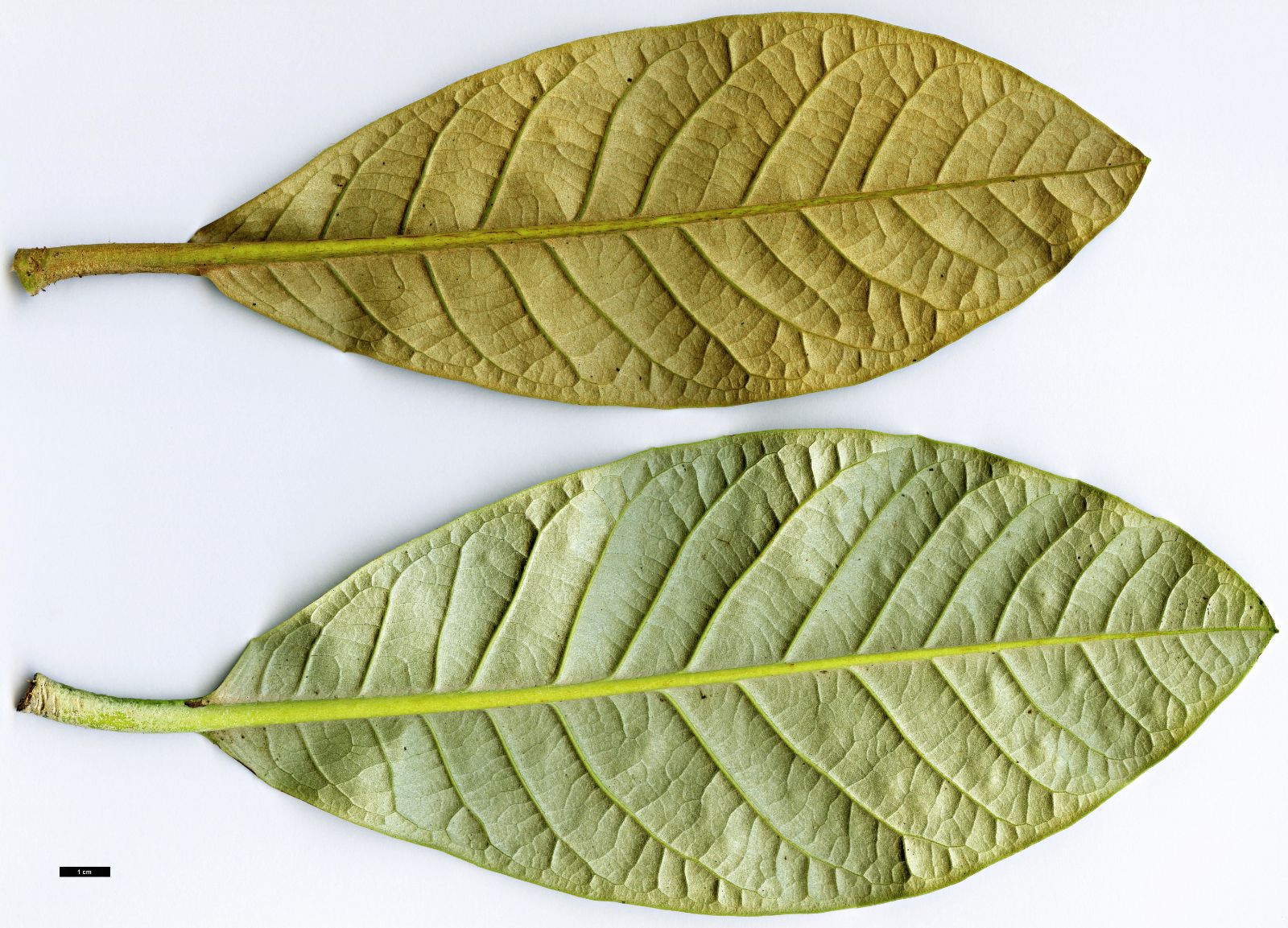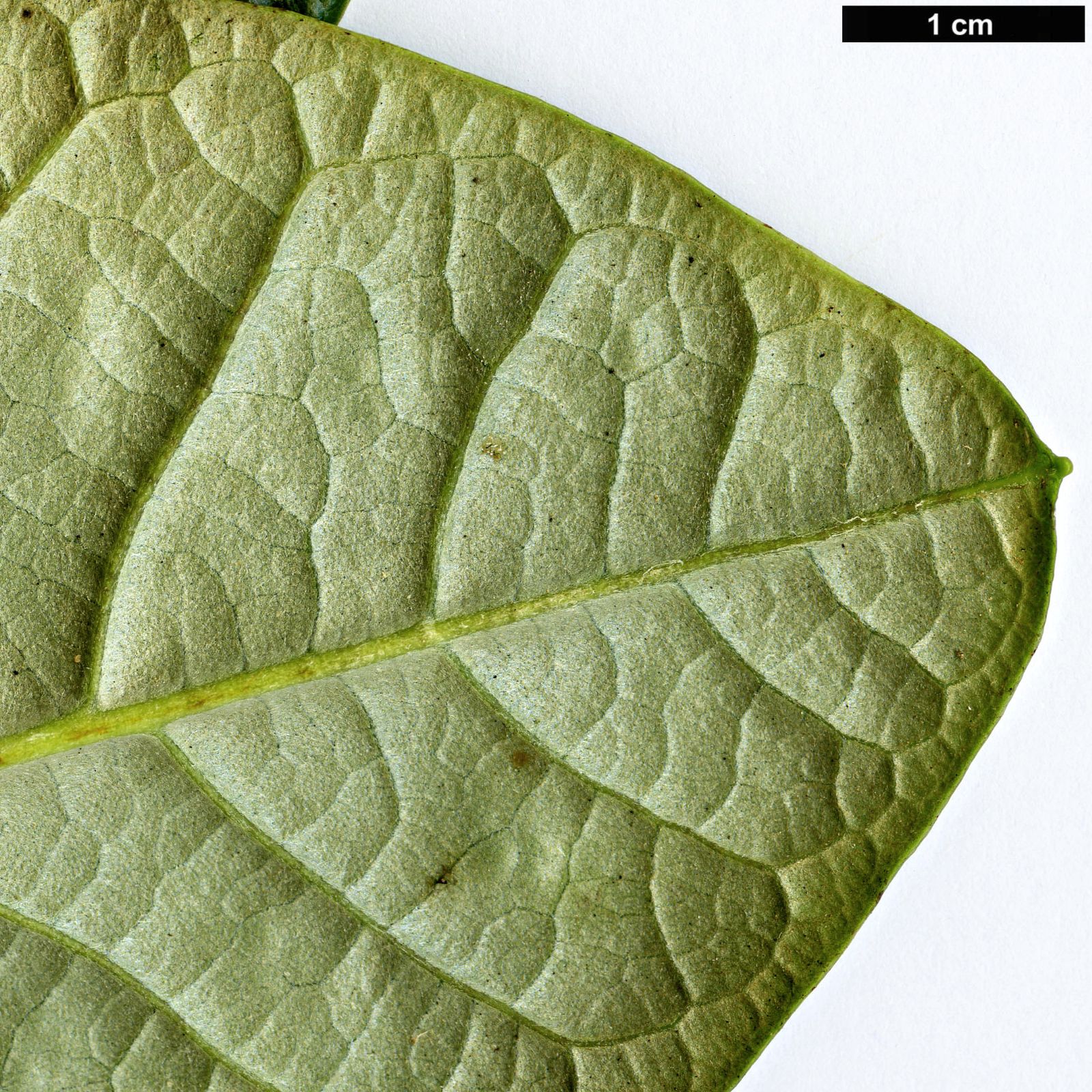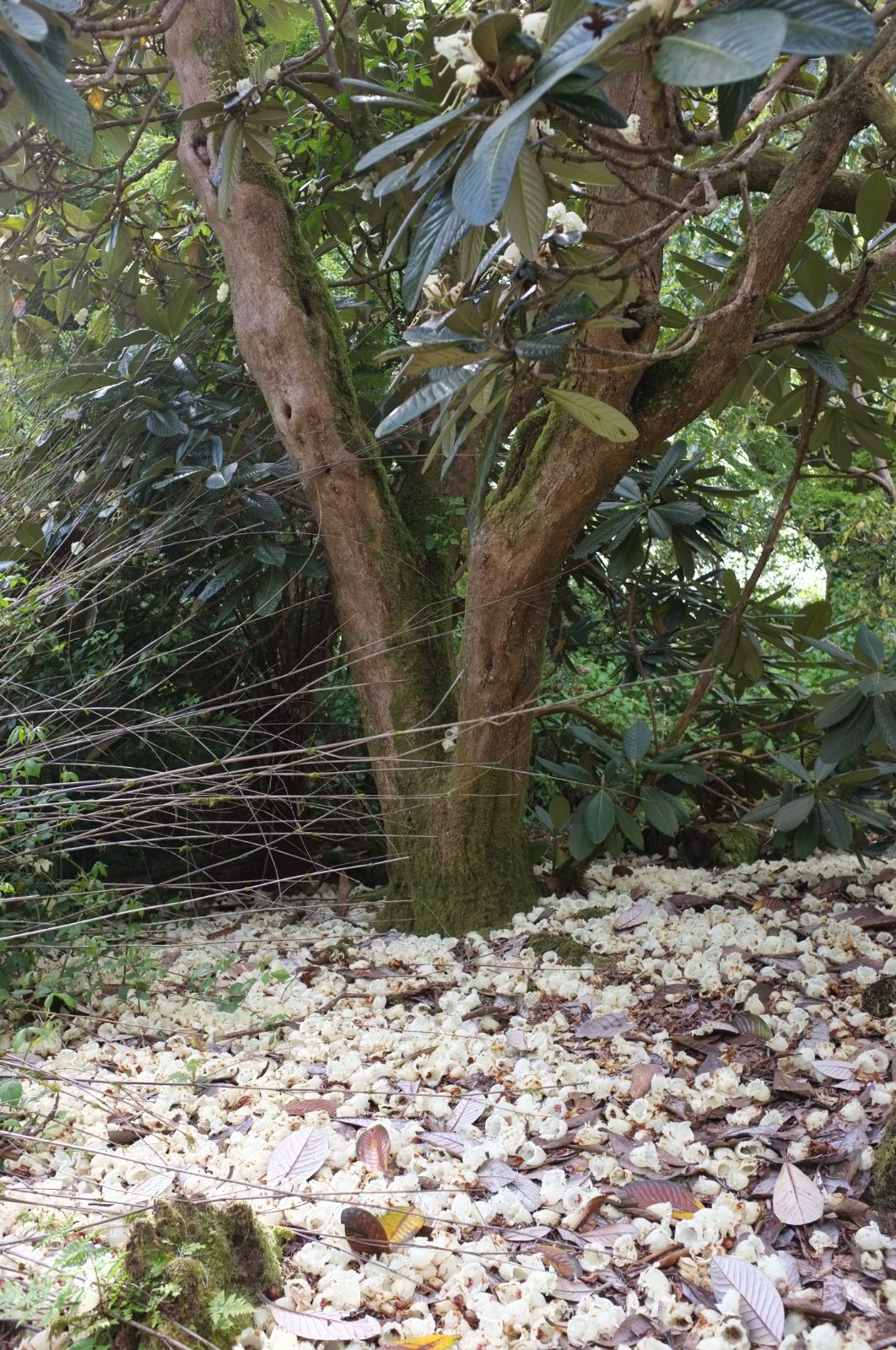Rhododendron sinogrande
Sponsor
Kindly sponsored by
Peter Norris, enabling the use of The Rhododendron Handbook 1998
Credits
Article from Bean's Trees and Shrubs Hardy in the British Isles
Recommended citation
'Rhododendron sinogrande' from the website Trees and Shrubs Online (treesandshrubsonline.
Genus
- Rhododendron
- Subsect. Grandia
Infraspecifics
Other taxa in genus
- Menziesia multiflora
- Rhododendron aberconwayi
- Rhododendron acuminatum
- Rhododendron adenogynum
- Rhododendron adenopodum
- Rhododendron adenosum
- Rhododendron aequabile
- Rhododendron afghanicum
- Rhododendron aganniphum
- Rhododendron agastum
- Rhododendron × agastum
- Rhododendron alabamense
- Rhododendron albertsenianum
- Rhododendron albiflorum
- Rhododendron albrechtii
- Rhododendron album
- Rhododendron alticolum
- Rhododendron alutaceum
- Rhododendron amagianum
- Rhododendron ambiguum
- Rhododendron amesiae
- Rhododendron anagalliflorum
- Rhododendron annae
- Rhododendron anthopogon
- Rhododendron anthopogonoides
- Rhododendron anthosphaerum
- Rhododendron anwheiense
- Rhododendron aperantum
- Rhododendron araiophyllum
- Rhododendron arborescens
- Rhododendron arboreum
- Rhododendron arfakianum
- Rhododendron argipeplum
- Rhododendron argyrophyllum
- Rhododendron arizelum
- Rhododendron armitii
- Rhododendron atlanticum
- Rhododendron atropurpureum
- Rhododendron atrovirens
- Rhododendron augustinii
- Rhododendron aureum
- Rhododendron auriculatum
- Rhododendron aurigeranum
- Rhododendron auritum
- Rhododendron austrinum
- Rhododendron baenitzianum
- Rhododendron bagobonum
- Rhododendron baileyi
- Rhododendron bainbridgeanum
- Rhododendron balangense
- Rhododendron balfourianum
- Rhododendron barbatum
- Rhododendron basilicum
- Rhododendron batemanii
- Rhododendron bathyphyllum
- Rhododendron beanianum
- Rhododendron beesianum
- Rhododendron beyerinckianum
- Rhododendron bhutanense
- Rhododendron blackii
- Rhododendron boothii
- Rhododendron brachyanthum
- Rhododendron brachycarpum
- Rhododendron bracteatum
- Rhododendron brevistylum
- Rhododendron brookeanum
- Rhododendron bryophilum
- Rhododendron bureavii
- Rhododendron bureavioides
- Rhododendron burmanicum
- Rhododendron burttii
- Rhododendron buxifolium
- Rhododendron caesium
- Rhododendron calendulaceum
- Rhododendron caliginis
- Rhododendron callimorphum
- Rhododendron calophytum
- Rhododendron calostrotum
- Rhododendron caloxanthum
- Rhododendron calvescens
- Rhododendron camelliiflorum
- Rhododendron campanulatum
- Rhododendron campylocarpum
- Rhododendron campylogynum
- Rhododendron camtschaticum
- Rhododendron canadense
- Rhododendron x candelabrum
- Rhododendron canescens
- Rhododendron capitatum
- Rhododendron carneum
- Rhododendron carolinianum
- Rhododendron carrii
- Rhododendron carringtoniae
- Rhododendron catacosmum
- Rhododendron catawbiense
- Rhododendron caucasicum
- Rhododendron cephalanthum
- Rhododendron cerasinum
- Rhododendron chaetomallum
- Rhododendron chamaethomsonii
- Rhododendron championiae
- Rhododendron charitopes
- Rhododendron chionanthum
- Rhododendron chlorops
- Rhododendron christi
- Rhododendron christianae
- Rhododendron chryseum
- Rhododendron chrysodoron
- Rhododendron ciliatum
- Rhododendron ciliicalyx
- Rhododendron cinnabarinum
- Rhododendron citriniflorum
- Rhododendron clementinae
- Rhododendron coelicum
- Rhododendron coeloneuron
- Rhododendron collettianum
- Rhododendron columbianum
- Rhododendron commonae
- Rhododendron complexum
- Rhododendron concinnum
- Rhododendron coriaceum
- Rhododendron coryanum
- Rhododendron cowanianum
- Rhododendron coxianum
- Rhododendron crassifolium
- Rhododendron crassum
- Rhododendron crinigerum
- Rhododendron cruttwellii
- Rhododendron cuffeanum
- Rhododendron culminicolum
- Rhododendron cumberlandense
- Rhododendron cuneatum
- Rhododendron cyanocarpum
- Rhododendron dalhousiae
- Rhododendron dasypetalum
- Rhododendron dauricum
- Rhododendron davidii
- Rhododendron davidsonianum
- Rhododendron decandrum
- Rhododendron × decipiens
- Rhododendron decorum
- Rhododendron degronianum
- Rhododendron dendricola
- Rhododendron dendrocharis
- Rhododendron denudatum
- Rhododendron desquamatum
- Rhododendron detonsum
- Rhododendron dianthosmum
- Rhododendron diaprepes
- Rhododendron dichroanthum
- Rhododendron dielsianum
- Rhododendron dignabile
- Rhododendron dilatatum
- Rhododendron dimitrium
- Rhododendron diphrocalyx
- Rhododendron discolor
- Rhododendron dryophyllum
- Rhododendron eclecteum
- Rhododendron × edgarianum
- Rhododendron edgeworthii
- Rhododendron elegantulum
- Rhododendron elliottii
- Rhododendron ericoides
- Rhododendron eriocarpum
- Rhododendron eriogynum
- Rhododendron erosum
- Rhododendron × erythrocalyx
- Rhododendron esetulosum
- Rhododendron eudoxum
- Rhododendron eurysiphon
- Rhododendron exasperatum
- Rhododendron excellens
- Rhododendron faberi
- Rhododendron facetum
- Rhododendron falconeri
- Rhododendron fallacinum
- Rhododendron fargesii
- Rhododendron farrerae
- Rhododendron fastigiatum
- Rhododendron faucium
- Rhododendron ferrugineum
- Rhododendron fictolacteum
- Rhododendron flammeum
- Rhododendron flavidum
- Rhododendron fletcherianum
- Rhododendron flinckii
- Rhododendron floccigerum
- Rhododendron floribundum
- Rhododendron flumineum
- Rhododendron formosanum
- Rhododendron formosum
- Rhododendron forrestii
- Rhododendron fortunei
- Rhododendron fragariiflorum
- Rhododendron fulgens
- Rhododendron fulvastrum
- Rhododendron fulvum
- Rhododendron galactinum
- Rhododendron gardenia
- Rhododendron genestierianum
- Rhododendron giulianettii
- Rhododendron glanduliferum
- Rhododendron glaucophyllum
- Rhododendron glischroides
- Rhododendron glischrum
- Rhododendron goodenoughii
- Rhododendron goreri
- Rhododendron gracilentum
- Rhododendron grande
- Rhododendron griersonianum
- Rhododendron griffithianum
- Rhododendron groenlandicum
- Rhododendron grothausii
- Rhododendron gymnocarpum
- Rhododendron habrotrichum
- Rhododendron haematodes
- Rhododendron hanceanum
- Rhododendron haofui
- Rhododendron headfortianum
- Rhododendron hedyosmum
- Rhododendron heftii
- Rhododendron heliolepis
- Rhododendron hellwigii
- Rhododendron hemitrichotum
- Rhododendron hemsleyanum
- Rhododendron herzogii
- Rhododendron hidakanum
- Rhododendron × hillieri
- Rhododendron himantodes
- Rhododendron hippophaeoides
- Rhododendron hirsutum
- Rhododendron hirtipes
- Rhododendron hodgsonii
- Rhododendron hongkongense
- Rhododendron hooglandii
- Rhododendron hookeri
- Rhododendron horlickianum
- Rhododendron houlstonii
- Rhododendron huianum
- Rhododendron hunnewellianum
- Rhododendron hyacinthosmum
- Rhododendron hylaeum
- Rhododendron hyperythrum
- Rhododendron hypoleucum
- Rhododendron imberbe
- Rhododendron impeditum
- Rhododendron imperator
- Rhododendron inconspicuum
- Rhododendron indicum
- Rhododendron inopinum
- Rhododendron insigne
- Rhododendron intranervatum
- Rhododendron intricatum
- Rhododendron irroratum
- Rhododendron japonicum
- Rhododendron jasminiflorum
- Rhododendron javanicum
- Rhododendron johnstoneanum
- Rhododendron kaempferi
- Rhododendron kanehirae
- Rhododendron kawakamii
- Rhododendron keiskei
- Rhododendron keleticum
- Rhododendron kendrickii
- Rhododendron kesangiae
- Rhododendron keysii
- Rhododendron kiusianum
- Rhododendron kiyosumense
- Rhododendron kongboense
- Rhododendron konori
- Rhododendron kyawii
- Rhododendron lacteum
- Rhododendron laetum
- Rhododendron lagopus
- Rhododendron lanatoides
- Rhododendron lanatum
- Rhododendron lanceolatum
- Rhododendron lanigerum
- Rhododendron lapponicum
- Rhododendron latoucheae
- Rhododendron laudandum
- Rhododendron lepidostylum
- Rhododendron lepidotum
- Rhododendron leptanthum
- Rhododendron leptocarpum
- Rhododendron leptothrium
- Rhododendron leucaspis
- Rhododendron leucogigas
- Rhododendron levinei
- Rhododendron lindaueanum
- Rhododendron lindleyi
- Rhododendron lochiae
- Rhododendron longesquamatum
- Rhododendron longiflorum
- Rhododendron longipes
- Rhododendron longistylum
- Rhododendron loranthiflorum
- Rhododendron lowii
- Rhododendron lowndesii
- Rhododendron luciferum
- Rhododendron ludlowii
- Rhododendron ludwigianum
- Rhododendron lukiangense
- Rhododendron luraluense
- Rhododendron luteiflorum
- Rhododendron lutescens
- Rhododendron luteum
- Rhododendron lyi
- Rhododendron lysolepis
- Rhododendron macabeanum
- Rhododendron macgregoriae
- Rhododendron macrophyllum
- Rhododendron macrosepalum
- Rhododendron maculiferum
- Rhododendron maddenii
- Rhododendron magnificum
- Rhododendron maius
- Rhododendron makinoi
- Rhododendron malayanum
- Rhododendron mallotum
- Rhododendron mariesii
- Rhododendron martinianum
- Rhododendron maximum
- Rhododendron maybarae
- Rhododendron meddianum
- Rhododendron megacalyx
- Rhododendron megeratum
- Rhododendron mekongense
- Rhododendron micranthum
- Rhododendron microgynum
- Rhododendron micromalayanum
- Rhododendron microphyton
- Rhododendron mimetes
- Rhododendron minus
- Rhododendron molle
- Rhododendron mollicomum
- Rhododendron mollyanum
- Rhododendron monosematum
- Rhododendron montroseanum
- Rhododendron morii
- Rhododendron moulmainense
- Rhododendron moupinense
- Rhododendron mucronatum
- Rhododendron mucronulatum
- Rhododendron multicolor
- Rhododendron multinervium
- Rhododendron myrtifolium
- Rhododendron nakaharae
- Rhododendron nakotiltum
- Rhododendron neoglandulosum
- Rhododendron neriiflorum
- Rhododendron nervulosum
- Rhododendron nigroglandulosum
- Rhododendron nipponicum
- Rhododendron nitidulum
- Rhododendron nivale
- Rhododendron niveum
- Rhododendron noriakianum
- Rhododendron notiale
- Rhododendron nudipes
- Rhododendron nuttallii
- Rhododendron oblongifolium
- Rhododendron obtusum
- Rhododendron occidentale
- Rhododendron ochraceum
- Rhododendron oldhamii
- Rhododendron orbiculare
- Rhododendron orbiculatum
- Rhododendron oreodoxa
- Rhododendron oreotrephes
- Rhododendron orthocladum
- Rhododendron ovatum
- Rhododendron pachypodum
- Rhododendron pachysanthum
- Rhododendron pachytrichum
- Rhododendron papillatum
- Rhododendron paradoxum
- Rhododendron parmulatum
- Rhododendron parryae
- Rhododendron parvifolium
- Rhododendron pauciflorum
- Rhododendron pemakoense
- Rhododendron pendulum
- Rhododendron pentaphyllum
- Rhododendron perakense
- Rhododendron peregrinum
- Rhododendron periclymenoides
- Rhododendron phaeochitum
- Rhododendron phaeochrysum
- Rhododendron piercei
- Rhododendron pingianum
- Rhododendron × planecostatum
- Rhododendron planetum
- Rhododendron pleianthum
- Rhododendron pleistanthum
- Rhododendron pocophorum
- Rhododendron poluninii
- Rhododendron polyanthemum
- Rhododendron polycladum
- Rhododendron polylepis
- Rhododendron ponticum
- Rhododendron praestans
- Rhododendron praeteritum
- Rhododendron praetervisum
- Rhododendron praevernum
- Rhododendron prattii
- Rhododendron preptum
- Rhododendron primuliflorum
- Rhododendron principis
- Rhododendron prinophyllum
- Rhododendron pronum
- Rhododendron proteoides
- Rhododendron protistum
- Rhododendron pruniflorum
- Rhododendron prunifolium
- Rhododendron przewalskii
- Rhododendron pseudochrysanthum
- Rhododendron pubescens
- Rhododendron pudorosum
- Rhododendron pulchrum
- Rhododendron pumilum
- Rhododendron purdomii
- Rhododendron purpureiflorum
- Rhododendron quadrasianum
- Rhododendron quinquefolium
- Rhododendron racemosum
- Rhododendron ramsdenianum
- Rhododendron rarilepidotum
- Rhododendron rarum
- Rhododendron recurvoides
- Rhododendron reticulatum
- Rhododendron retivenium
- Rhododendron retusum
- Rhododendron rex
- Rhododendron rhodoleucum
- Rhododendron rigidum
- Rhododendron ripense
- Rhododendron ririei
- Rhododendron robinsonii
- Rhododendron roseatum
- Rhododendron rothschildii
- Rhododendron roxieanum
- Rhododendron rubiginosum
- Rhododendron rubineiflorum
- Rhododendron rubropilosum
- Rhododendron rufum
- Rhododendron rugosum
- Rhododendron rupicola
- Rhododendron russatum
- Rhododendron saisiuense
- Rhododendron saluenense
- Rhododendron sanctum
- Rhododendron sanguineum
- Rhododendron santapaui
- Rhododendron sargentianum
- Rhododendron saxicolum
- Rhododendron saxifragoides
- Rhododendron sayeri
- Rhododendron scabridibracteum
- Rhododendron scabrifolium
- Rhododendron scabrum
- Rhododendron schlippenbachii
- Rhododendron schoddei
- Rhododendron scintillans
- Rhododendron scopulorum
- Rhododendron searleanum
- Rhododendron searsiae
- Rhododendron seinghkuense
- Rhododendron selense
- Rhododendron semibarbatum
- Rhododendron semnoides
- Rhododendron serotinum
- Rhododendron serpyllifolium
- Rhododendron sessilifolium
- Rhododendron setosum
- Rhododendron × sheilae
- Rhododendron shepherdii
- Rhododendron sherriffii
- Rhododendron shweliense
- Rhododendron sidereum
- Rhododendron siderophyllum
- Rhododendron sikangense
- Rhododendron simiarum
- Rhododendron simsii
- Rhododendron sinofalconeri
- Rhododendron smirnowii
- Rhododendron × sochadzeae
- Rhododendron solitarium
- Rhododendron sororium
- Rhododendron souliei
- Rhododendron sperabile
- Rhododendron sperabiloides
- Rhododendron sphaeroblastum
- Rhododendron spiciferum
- Rhododendron spilotum
- Rhododendron spinuliferum
- Rhododendron stamineum
- Rhododendron stapfianum
- Rhododendron stenopetalum
- Rhododendron stenophyllum
- Rhododendron stevensianum
- Rhododendron stewartianum
- Rhododendron strigillosum
- Rhododendron suaveolens
- Rhododendron subansiriense
- Rhododendron subsessile
- Rhododendron succothii
- Rhododendron sulfureum
- Rhododendron sumatranum
- Rhododendron superbum
- Rhododendron sutchuenense
- Rhododendron taggianum
- Rhododendron taliense
- Rhododendron tanastylum
- Rhododendron tapetiforme
- Rhododendron tashiroi
- Rhododendron tatsienense
- Rhododendron telmateium
- Rhododendron temenium
- Rhododendron tephropeplum
- Rhododendron thayerianum
- Rhododendron thomsonii
- Rhododendron thymifolium
- Rhododendron tolmachevii
- Rhododendron tomentosum
- Rhododendron tosaense
- Rhododendron traillianum
- Rhododendron trichanthum
- Rhododendron trichocladum
- Rhododendron trichostomum
- Rhododendron triflorum
- Rhododendron tsariense
- Rhododendron tschonoskii
- Rhododendron tschonoskyi
- Rhododendron tsusiophyllum
- Rhododendron tuba
- Rhododendron ungernii
- Rhododendron uniflorum
- Rhododendron uvariifolium
- Rhododendron vaccinioides
- Rhododendron valentinianum
- Rhododendron vaseyi
- Rhododendron veitchianum
- Rhododendron venator
- Rhododendron vernicosum
- Rhododendron verruculosum
- Rhododendron versteegii
- Rhododendron vesiculiferum
- Rhododendron vialii
- Rhododendron vilmorinianum
- Rhododendron virgatum
- Rhododendron viridescens
- Rhododendron viscidifolium
- Rhododendron viscosum
- Rhododendron vitis-idaea
- Rhododendron wadanum
- Rhododendron wallichii
- Rhododendron walongense
- Rhododendron wardii
- Rhododendron wasonii
- Rhododendron watsonii
- Rhododendron websterianum
- Rhododendron weyrichii
- Rhododendron wightii
- Rhododendron williamsianum
- Rhododendron williamsii
- Rhododendron wilsoniae
- Rhododendron wiltonii
- Rhododendron womersleyi
- Rhododendron wongii
- Rhododendron wrightianum
- Rhododendron xanthocodon
- Rhododendron xanthostephanum
- Rhododendron yakushimanum
- Rhododendron yedoense
- Rhododendron yelliotii
- Rhododendron yongii
- Rhododendron yungningense
- Rhododendron yunnanense
- Rhododendron zaleucum
- Rhododendron zeylanicum
- Rhododendron zoelleri
Tree, 6–12 m; bark rough. Leaves 20–70 × 8–30 cm, oblanceolate to broadly elliptic, apex rounded or retuse, minutely apiculate, lower surface with a silvery compacted and agglutinated indumentum, that is largely composed of rosulate hairs; petioles terete. Flowers 8–10-lobed, pale creamy white, with a purple basal blotch, ventricose-campanulate, with nectar-pouches, 40–60 mm; stamens 18–20; ovary densely rufous-tomentose. Flowering April-May. Royal Horticultural Society (1997).
Distribution Myanmar NE China SE Tibet, Yunnan
Habitat 2,450–4,250 m
RHS Hardiness Rating H4
Awards AM 1922 (Dame Alice Godman, Horsham); flowers creamy white, with a crimson blotch. FCC 1926 (G.H. Johnstone, Trewithian, Cornwall); flowers ivory white, with a big crimson blotch. AGM 1993
Conservation status Least concern (LC)
Taxonomic note The very large leaves with an agglutinated indumentum will distinguish this species. Hybrids between R. sinogrande and R. macabeanum occur in cultivation. Royal Horticultural Society (1997)
An evergreen shrub or a tree up to 35 ft high, the young shoots silvery grey, very stout, and up to 1 in. thick. Leaves oval or oblong, occasionally obovate, rounded at both ends, ordinarily 10 to 20 in. long, 6 to 12 in. wide, at first grey scurfy above, ultimately dark green and glabrous, silvery grey beneath with a closely appressed scurf, not downy or hairy in the ordinary sense of those words; midrib very prominent beneath as are also the fourteen to sixteen pairs of roughly parallel veins springing from it; stalk very stout (up to 1⁄2 in. thick) 1 to 2 in. long. Flowers produced in April in a racemose truss of twenty to thirty, and about 9 in. wide; pedicels about 11⁄2 in. long, densely woolly. Calyx woolly, fringed with small teeth. Corolla bell-shaped, fleshy, dull creamy white to soft yellow, marked with red patches at the base, 2 in wide, eight- to ten-lobed, the lobes 3⁄4 in wide, notched. Stamens eighteen or twenty, downy towards the base, shorter than the corolla. Ovary covered with reddish down; style glabrous; stigma 2⁄5 in. wide. Bot. Mag., t. 8973. (s. Grande)
R. sinogrande was discovered by Forrest in 1912, growing at 11,000 ft on the western flank of the Shweli-Salween divide, latitude 250 20′ N. The plants were in fruit and from them the species was introduced to gardens (F.9021). In this area, on the borders between Burma and mid-Yunnan, R. sinogrande is at the south-eastern extremity of its area. From here it ranges along the mountains between the Salween and the eastern branch of the Irrawaddy to some way north of 28° and is also found east of the Salween in this latitude. Most of Forrest’s later sendings are from this northeastern corner, where Burma, China and Tibet adjoin. Westward it ranges across the upper Irrawaddy to the Delei valley in the Mishmi Hills, Assam, but its western limit is uncertain.
‘R. sinogrande sometimes forms forests single-handed. We passed through whole glades of its gnarled and twisted branches, when its pale yellow globes were alight and shining brighdy under the dark canopy of leaves. Some of the trunks were twenty-four inches round… . One advantage about R. sinogrande is the lateness of its new growth. The great spear-headed buds burst in July, and even in August one can pick out the trees a mile away by the plumes of silver foliage shooting up from ruby-red tubes’ (Kingdon Ward, Plant Hunting on the Edge of the World, p. 277, in reference to R. sinogrande in the Mishmi Hills).
Botanically this is the eastern counterpart of R. grande, differing in the eglandular ovary and pedicels and the shorter and stouter style. In leaf it is much the finer species and in that respect the most splendid and remarkable of all rhododendrons, or indeed of all woody plants hardy in this country. In the Cornish woods, where it first faced the English climate, leaves 21⁄2 ft long and 1 ft or more wide have been produced on young plants. It first flowered at Heligan in Cornwall in May 1919. It grows fastest and has attained the largest size in the Atlantic zone, but in woodland gardens south of London it is perfectly at home and flowers just as well as in the milder parts. It is nearly hardy and in some forms completely so. In the Windsor collection some plants were cut to the ground by the freezing winds of February 1956, but others were unharmed or almost so, and none was actually killed (R.C.Y.B. 1957, p. 62).
R. sinogrande was awarded a First Class Certificate when shown by G. H. Johnstone, Trewithen, Cornwall, on March 9, 1926. Four years earlier, Dame Alice Godman had shown a truss from a plant grown under glass at South Lodge, Sussex, and the species had then received an Award of Merit as a tender rhododendron. The plant was a gift from J. C. Williams of Caerhays and also provided the truss figured in the Botanical Magazine.
From the Supplement (Vol. V)
The var. boreale is not recognised in the Edinburgh revision.

